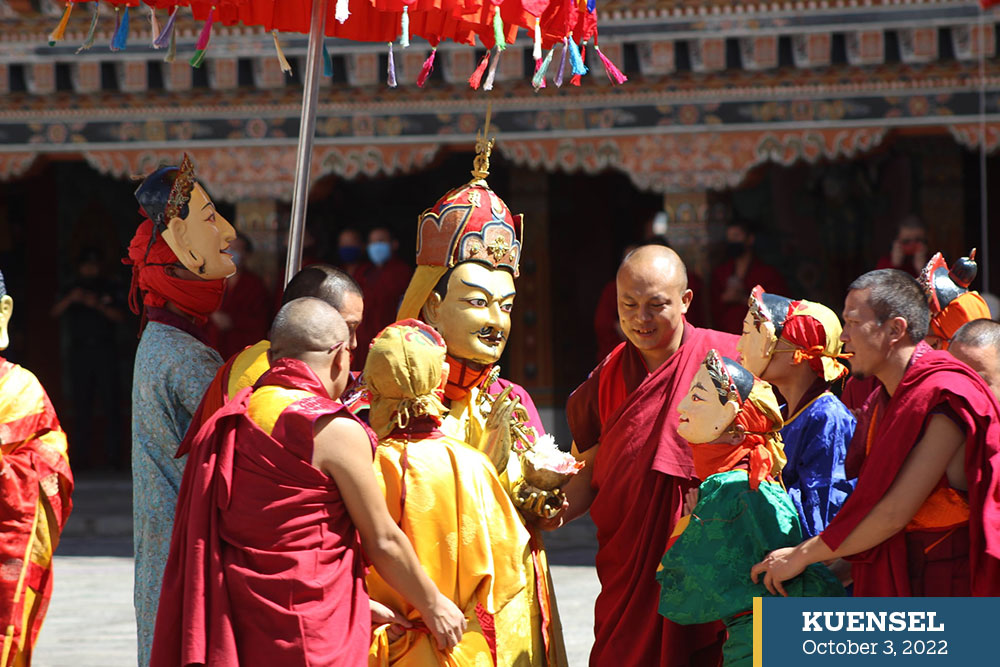The 3-day annual Thimphu tshechu wii begin from tomottow. Some salient features of the tshechu are:
Day One
Dance of 21 Black Hats with Drums (Zhana Nga Cham):
After destroying the spiteful enemies who persecute the beings and Buddhism, the Black Hat dancers beat their great drums. The sound of the drums represents religion because Buddhism has no visible form.
The Black Hat Dancers assume the appearance of yogis who have the power of taking and recreating life. They subdue and lead to the field of Buddha those who are unwilling to be led. They accomplish this by manifesting external anger while being completely at peace within. Five fiendish enemies, which represent sins, disappear in the sphere of emptiness with the appearance of the Black Hat Tantrists.
This dance can also be referred to as “Gar” dance. It is derived from a different tradition of the tantras. The Black Hat Dancers who perform the ritual for the earth firstly build a mandala and then cut the demons into pieces. Thus, they take possession of the earth in order to further protect it and they dance the step of a thunderbolt to imprint their power on it. (The Thunderbolt step is a particular step in the religious dances).
This ground purification rite is also performed when constructing Dzongs, temples and stupas to conciliate the malevolent beings of the ground and take possession of the site. The dancers assume the appearance of yogis, who show great and passionate anger externally but actually have accomplished and peaceful minds.
Day Two
Dance of the Lords of the Cremation Grounds (Durdag):
On the external edges of a symbolic mandala where the assembly of the secret tantric deities reside, there are eight large cremation grounds. Living in these cremation grounds are numerous lords (Chhoechong) who are bound by an oath to protect the religion.
Among them are the Lords of the Cremation Grounds. Because of a promise they had accepted before and from which they cannot be diverted even for one instant, these Lords render powerless the assembly of demonic enemies who have violated their oath of not harming the Doctrine. They offer them to the gods of the mandala and reduce them to a mere name.
Dance of the Terrifying Deities (Tungam)
This very spectacular and dramatic dance has deep symbolic meaning, namely that a sacrificial murder is performed. First the dancers representing the gods try to enclose the evil spirits in a circle and then into a triangle box.
Once this is done, the main god who holds the ritual dagger (phurba), kills them physically, but actually delivers them into salvation at the same time. This dance demonstrates the passage of men and the demi-gods (asuras) who become enemies of Buddhism. Hence, Guru Rinpoche, who is the emanation of all the Buddhas, took the form of “Fierce Thunderbolt” (Dorje Dragpo). By slaying these enemies he liberated them into the superior sphere of bliss.
By performing such an incredible feat which resulted in the happiness of the human world, he helped increase faith in non-illusionary acts.
This dance is intended to deliver all sentient beings by showing them Zangtopelri, the paradise of Guru Rinpoche. Guru Rinpoche takes the fiery form of Dorji Dragpo, because it is the perfect manifestation to liberate the men and demons that oppose Buddhism. The dancers representing the gods enclose the evil spirits in a circle and in a box, after which the god, who holds the phurba, the ritual dagger, kills them.
Day Three
Dance of the Eight Manifestations of Guru (Guru Tshen Gyed)
Ugyen Rinpoche is the Second Buddha and the incarnation of Avalokiteshvara (Thugje Chenpo), Lord of Compassion. The Tshechu is a festival in honour of Padmasambhava – “one who was born from a lotus flower”, popularly also addressed as “Guru Rimpoche”, the Precious Teacher.
This dance starts with the entrance of Guru Dorje Dholo dressed in a colourful brocade dress and wearing a terrifying red mask. Order of entry: Tshokye Dorje – Brocade dress, a blue mask with the third eye, and carrying a dorji and drilbu. Padmasambhava – Red and yellow dress, white mask, high red hat. Loden Chogsey – Red and yellow dress, in a white mask. Guru Rinpoche sits under a silk canopy, wearing a golden mask. He is surrounded by attendant fairies in white masks. The fairy who is standing on the right of Guru Rinpoche is Mandeyrawa, the lady of wisdom. Ugyen Rinpoche made her his own emanation for the benefit of the beings to be converted in the Kingdom of Zahor. The fairy who is standing at his left is Yeshey Tshogyel. She is representation of the goddess of knowledge, mother of all the Buddhas. She helped to establish Buddhism in Tibet for the benefit of all beings. Shakya Senge -Red and yellow monk dress, resembling Buddha carrying a bowl. Pema Gyelpo – brocade dress, in a red bearded mask Nima Yoezer – A yellow bearded mask, carrying a trident and the sun in his hands. Sengye Dradrog -Blue brocade dress, terrifying blue mask, followed by his retinue, all wearing the blue masks. Guru Rinpoche goes and sits under canopy, while all the other manifestations dance in turns. When the demonstration of the eight manifestations is completed, all are seated in their order beside the Guru. Then appear the Sixteen Fairies (Rigma Chudrug) who sing and perform two dances in front of Guru and his eight manifestations: They dance, first holding drums, then small handbells and small hand drums. They have beautiful dresses decorated with minute ivory carvings. After this performance, the fairies lead the whole entourage out.
This dance shows the eight different forms that Guru Rinpoche assumed in order to bring different beings unto the Buddhist fold. The Guru Tshengye dance is said to bring total happiness to people.


